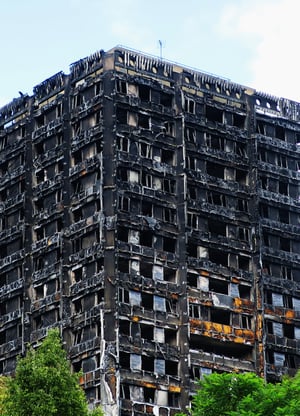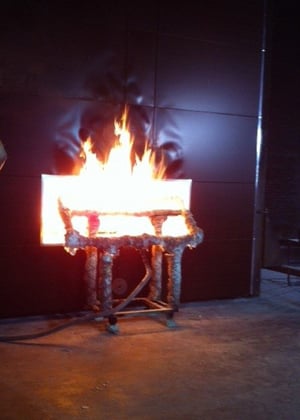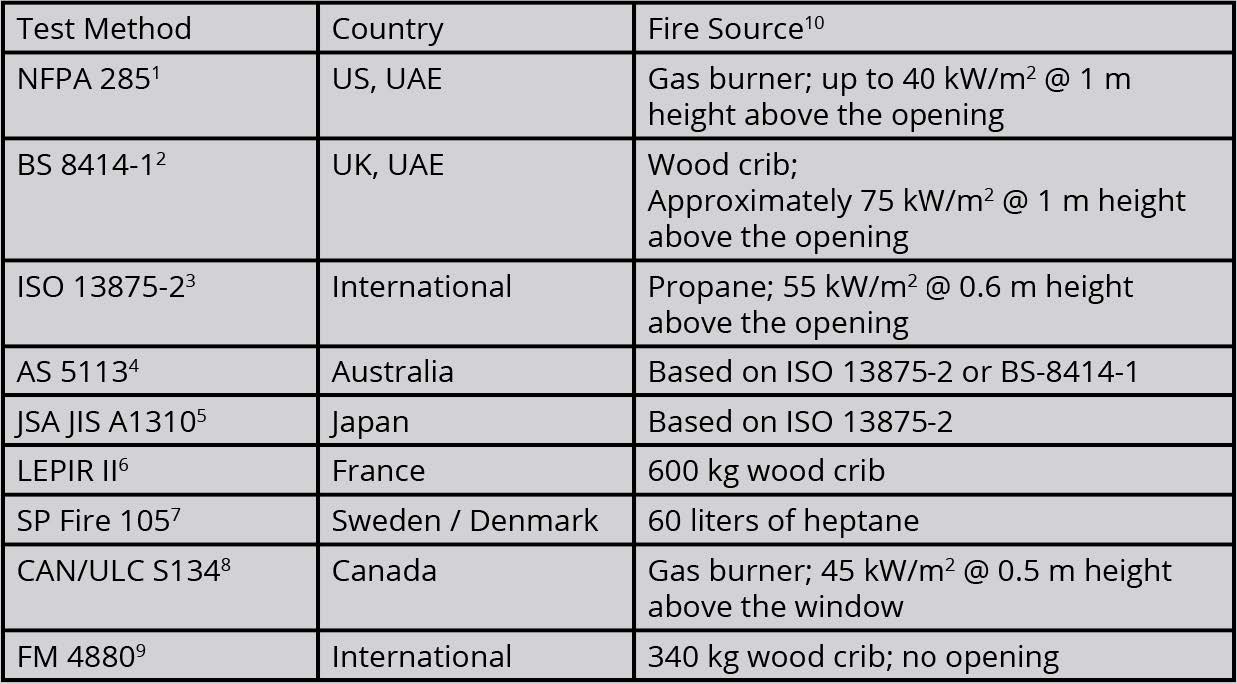Catastrophic Exterior Wall Fires in High-Rise Buildings
Horrific fires involving the exterior walls of high-rise buildings have fueled debate over how to best mitigate rapid-fire progression on building exteriors. These fires represent a global challenge that begs for a solution.
Recent exterior wall fires involving high-rise buildings have fueled discussion and debate over how to mitigate rapid-fire progression on exterior walls that are clad with various construction materials.
 To better understand the exterior wall flammability issue and move towards solutions this article will:
To better understand the exterior wall flammability issue and move towards solutions this article will:
- Discuss the factors that influence building construction related to these types of fires
- Provide an understanding of certain fire tests that are sometimes misconstrued as suitable for the evaluation of exterior walls
- Examine the importance of selecting tests for specific regions, codes, and regulations
The article will also cover UL’s third-party certification approach that can be used to identify exterior wall assemblies that have successfully complied with required test methods. This information can hopefully be useful in preventing future exterior wall fires of these types.
In October 2019, the long-awaited Grenfell Tower Inquiry Phase 1 Report was released. The Grenfell Tower inquiry is a public investigation independently examining the circumstances surrounding the fire at Grenfell Tower that occurred on June 14, 2017. According to the inquiry report a fire broke out on the fourth floor of the 24-story housing flat in North Kensington, London, and spread to the building exterior. It quickly raced up the building exterior, ultimately resulting in 72 deaths. The report can be viewed at https://www.grenfelltowerinquiry.org.uk/phase-1-report.
Construction Considerations
 There are several factors influencing exterior wall construction today. First, due to the fast pace of today’s construction and the need for less costly, easier to install designs, new materials are constantly being introduced into the marketplace. The combination of new and existing products creates an expansive list of exterior wall components options for designers and builders. The material combinations and their means of installation must be evaluated appropriately to determine whether they are suitable for use as a complete assembly. Fire testing has demonstrated that the testing individual materials does not always result in a reliable determination of fire performance once multiple materials are combined into an exterior wall system. It is only through fire testing of the complete wall assembly that an accurate assessment of fire performances can be made.
There are several factors influencing exterior wall construction today. First, due to the fast pace of today’s construction and the need for less costly, easier to install designs, new materials are constantly being introduced into the marketplace. The combination of new and existing products creates an expansive list of exterior wall components options for designers and builders. The material combinations and their means of installation must be evaluated appropriately to determine whether they are suitable for use as a complete assembly. Fire testing has demonstrated that the testing individual materials does not always result in a reliable determination of fire performance once multiple materials are combined into an exterior wall system. It is only through fire testing of the complete wall assembly that an accurate assessment of fire performances can be made.
Another challenge is the growing attention to building envelope performance such as thermal performance, air leakage, permeability, water infiltration, etc. In some areas, this is even driven by local codes and regulations. The result is insulation products with higher thermal properties and increased use of air barriers and vapor barriers. Consequently, these new wall constructions also require testing and evaluation for their conformance to the appropriate exterior wall fire requirements as a complete unit.
Another building construction factor is the increased use of exterior veneer materials that are aesthetically pleasing, but lack evidence of compliance with codes or regulations for fire safety. Around the globe, especially since the Grenfell tragedy, there has been a strong focus on the challenges associated with non-fire-retardant metal composite panel construction, which is versatile and aesthetically pleasing, but does not always perform well when subjected to certain exterior wall
fire tests.
Holistic Fire Safety Approach
Many building professionals, fire protection experts and design professionals are aware that taking a holistic approach to fire protection within buildings is ideal. This includes choosing materials that have been assessed for their reaction-to-fire properties (to slow the spread of fire) and considering detection and alarm, fire suppression and compartmentalization. However, there is not always a clear understanding of which fire tests or protection approaches should be used for exterior wall fires.
For example, there have been discussions in some areas about relaxing requirements for exterior wall testing if the interior of the building is protected by sprinklers. For an exterior wall fire originating external to the building, it should be understood that the interior sprinkler system is not designed to protect the building’s exterior surface, so significant fire and smoke damage could still occur to the structure.
Selecting an Appropriate Fire Test
Another misconception is that the large-scale fire test conducted in accordance with UL 263 Standard for Fire Tests of Building Construction and Materials (ASTM E 119) which is used to establish hourly fire resistance ratings should be challenging enough to examine fire growth for an exterior wall assembly. This test method is useful for evaluating building assemblies for limiting the spread of flame between building compartments (utilizing walls and/or horizontal assemblies) or protecting structural steel members such as beams and columns. However, it is not intended to evaluate fire progression extending to the outside of an exterior wall assembly, which was an important factor in the Grenfell Tower and other recent high-rise fires, such as:
Monte Carlo Hotel, Las Vegas Nevada – 2008
Mermoz Tower, France – 2012
Lacrosse Building, Melbourne Australia – 2014
Torch Tower, Dubai UAE – 2015
Address Downtown Hotel, Dubai UAE – 2015
Grenfell Tower, London England – 2017
Torch Tower, Dubai UAE – 2017
Tests such as the NFPA 285 multi-story apparatus fire test are specifically designed to evaluate the ability of an exterior wall system to prevent an interior contents fire to leapfrog up the outside of an exterior wall system.

Table 1 - Exterior Wall Test Methods
International Exterior Wall Test Considerations
In recognition of the importance of establishing the most representative test, there are various standards groups around the world focusing on exterior wall test methodologies. The good news is that the issue of flammability of exterior walls is being addressed seriously, and many jurisdictions are updating or creating new codes and performance standards. The challenge is that there are several different methods being implemented in different countries and regions that may not have the exact same scope or deliver the same outcomes. It is important to understand the methods used to qualify a product or system to ensure it is suitable for use in exterior wall construction.
Many of these prominent full-scale exterior wall fire test methods are already embedded into codes and regulations. For example, the International Building Code (IBC) and NFPA 5000 make reference to NFPA 285 for buildings of Types I, II, III and IV over 40 feet in height and buildings employing foamed plastics in the exterior wall. Table 1 lists some of the test methods and the countries where they are typically enforced. This is not intended to be a comprehensive list, as there are other methods under development.
Certifications Approach
Historically, the acceptance of wall systems utilizing non-combustible materials involved a fairly complex review of building code requirements, test reports covering individual components, engineering analysis and manufacturer’s installation instructions. With the increased demand and availability of combustible insulation products, combustible water barriers and façade veneers coupled with the occurrence of several catastrophic exterior wall fires on high-rise buildings, fire prevention requires a robust fire testing and certification program for wall assembly systems to determine that installed systems comply with the most current model codes and standards.
Dwayne E. Sloan
Technical Director, Building & Life Safety Technologies UL LLC
Dwayne Sloan is the Technical Director for UL’s Built Environment division. Dwayne provides technical oversight of certification and testing activities for exterior wall systems among many other product areas. He serves on several international, UL, NFPA, and ASTM committees, including the NFPA Fire Test Committee responsible for NFPA 285. During his 32 years at UL, he has worked in and managed a variety of UL’s fire protection areas, with 17 years as the Reaction to Fire Principal Engineer. He is the current Chair of UL’s Fire Council and is a UL Corporate Fellow. For more information regarding this topic contact Dwayne Sloan at brett@altaengineeringco.com or visit www.ul.com/exteriorwalls.
More In The News
Subscribe Today!
Stay-in-the-know and subscribe to our blog today!
